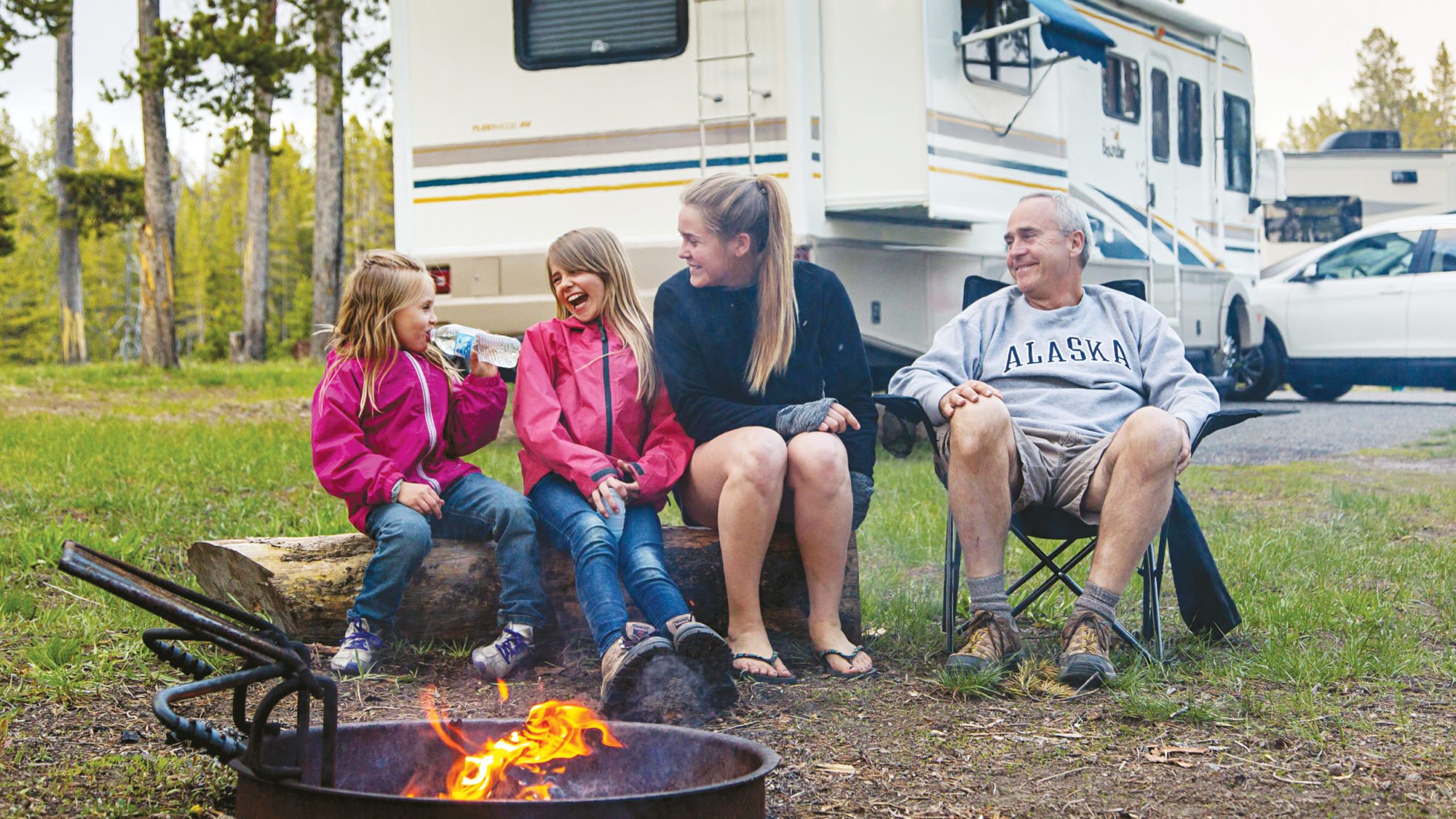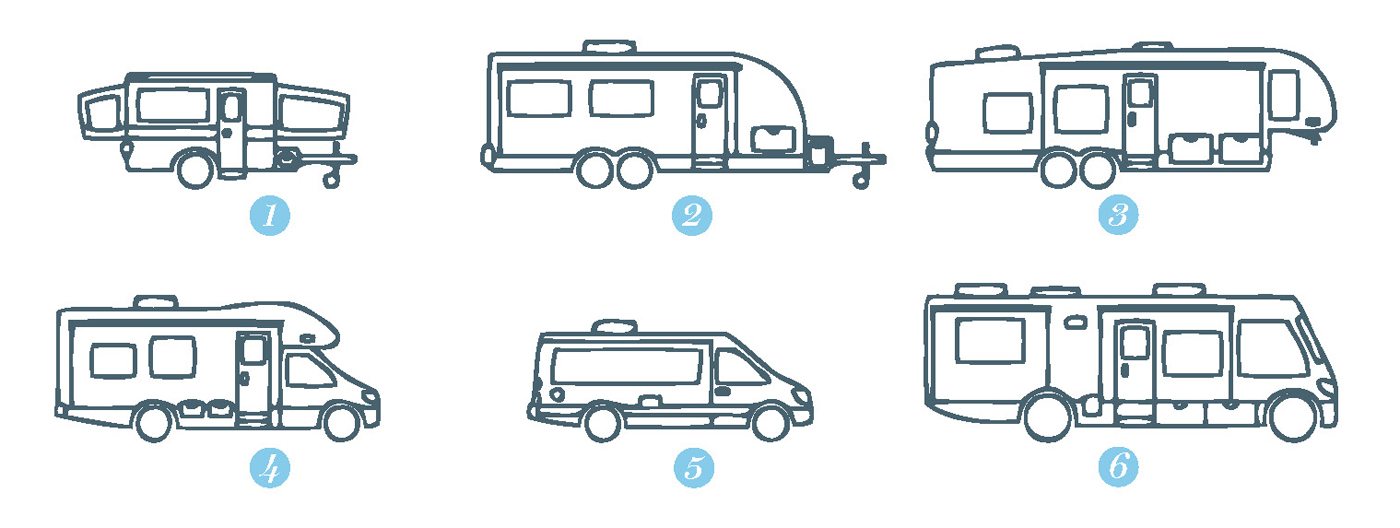Driving an RV is a great way to see North America, but don’t take our word for it—try out the Alberta RV lifestyle for yourself!
HOW TO BUY AN RV
To see if you’re cut out for RV life, rent before buying. “You’ll get an idea of how capable your truck is, and how comfortable you are pulling an RV,” says Sarnesh Narayan, vice-president of operations at Go RV, an AMARewards partner with dealerships in Red Deer and Leduc.
You’ll get a taste of what it’s like to travel with your accommodations, before committing to a purchase. It’ll also help you decide how much space you really need. At Go RV, you can rent a 27-foot RV, which sleeps eight people, for about $1,200 per week. Buy an RV later and that payment will be deducted from the price.
If you do decide to buy, Narayan recommends getting a new unit rather than used—to take advantage of the warranty and the likelihood of fewer repairs. But remember to factor in maintenance and service costs, as all RVs still require regular maintenance. “It’s very important to work with a dealer that has a trusted service department,” Narayan says.
The cost of a new 14-foot trailer typically starts at $15,000. A new 27-footer, the most common size, usually costs between $20,000 and $30,000. Motorhomes are more expensive—some Class A models can easily top $100,000. Purchase a new or previously owned RV from Go RV and you’ll receive a one-year AMA Plus RV membership, one year of free RV storage and free access to the Go RV Adventure Club.
CHOOSE A MODEL
There’s a recreational vehicle to suit every taste and budget:
1. Tent trailer
Pros: The most affordable option, lightest to tow
Cons: Needs set-up before use, limited storage
2. Travel trailer
Pros: Easy to tow by SUVs and minivans with a regular hitch
Cons: Limited space
3. Fifth wheel (goose-neck)
Pros: Lots of space, leaves tow vehicle free for use when parked
Cons: Needs pickup truck for towing
YOU TELL US!
Got a fave RV destination or park? Tell us about it at AMAInsider@ama.ab.ca
4. Class C motorhome (bunk-over)
Pros: Comfortable and contained
Cons: Limited space, no vehicle for use when parked
5. Class B motorhome (camper van)
Pros: Small and compact for going anywhere, can be luxurious
Cons: Limited space for more than two people
6. Class A motorhome (bus)
Pros: Loads of room, luxurious
Cons: Expensive to buy and operate
INSURE YOUR RIDE
It’s essential to have the right coverage for your RV. A trailer is usually covered under your existing automotive liability insurance when it’s attached to your vehicle—but only for liability. Once the RV is detached, coverage is no longer mandatory, but you’ll likely want to protect against any damage.
Another option would be to add it to your auto or your home and property policies. If you have a motorhome or camper van, it’s considered a vehicle in its own right, so must have its own auto policy for liability. You can also purchase extra coverage for contents or physical damage to the unit itself.
“Under an automotive policy, you’re dealing with the unit itself,” says Mike Mantello of AMA Insurance. “With a property policy, you’ve got the unit itself (with a certain value) and its contents.”
This means the trailer can be insured for fire, theft and collision under an auto policy, which also includes permanently-attached items inside, like beds and benches. Under a property policy, coverage includes separate contents such as bedding, kitchen items, TVs and even bicycles. Anything attached to the RV, like ATVs and motorcycles in a hauler, can also be covered, but a separate policy may be necessary.
A common myth is that your home insurance covers the RV contents when it’s parked in your driveway. “This isn’t necessarily true,” Mantello says. “Anything that’s kept in the RV on a permanent basis should have its own coverage.” And if you sell your house to hit the road year-round, the RV becomes your principle residence and you’ll need an entirely different policy. Speak to an AMA Insurance advisor to discuss your specific needs.

BEHIND THE WHEEL
“The vast majority of people have no problem jumping into an RV and driving it with no issues whatsoever,” says Rick Lang, AMA’s manager of novice operations for driver education.
“The biggest challenge is that it’s a little wider, a lot taller and usually much longer. When you get into close proximity situations—like backing up in a campground—things can happen.”
An Alberta driver with a regular Class 5 licence is allowed to drive almost any size of RV, provided it’s not equipped with air brakes. AMA offers RV Smart, a four-hour course, during which the instructor rides along with the RV driver and passenger to teach them how to safely control this larger vehicle.
Instruction focuses on safety, towing, braking, parking, hazard awareness and accident prevention. Instructors show techniques for backing up and going around tight corners, as well as making more frequent mirror checks and looking farther ahead on the road.
MORE TO READ
10 road trip–worthy RV destinations in the west
“We can improve virtually anyone’s ability to drive,” Lang adds. Passengers also benefit from instruction: “Sooner or later, for whatever reason, a passenger may also be required to drive this thing. It’s better to do so in a controlled situation, with an instructor, rather than all of a sudden you’re out there by yourself and you have no clue.”
ROADSIDE ASSISTANCE
If you run into problems on the road, towing could result in a trailer-size bill. Operators charge by the hour and a RV tow could take upwards of five hours, including transportation, loading, drop-off at a shop and unloading.
That’s why AMA offers special coverage to protect RV drivers. Last summer, two members needed their 53-foot motorhome towed from Pincher Creek to Lethbridge, a distance of about 125 kilometres. “Thankfully, they were AMA Plus RV members,” says Brandon Klassen of AMA Roadside Assistance. “The cost of the tow was covered under their $181 membership fee—significantly less than the total non-member tow cost of about $1,000.”
Choose from two plans: Plus RV and Premier RV. Plus includes free towing of your truck, trailer or even full-size motorhome up to 160 km, for five tows a year. Premier provides one tow of up to 320 km, and an additional four tows of 160 km per membership year. If both your truck and trailer need to be towed, that will count as two tows because it requires two tow trucks.
Premier RV also includes exclusive extras, like trip-interruption protection, windshield-chip repair and home-lockout reimbursement. And if you lock yourself out at the campsite, AMA will be there to help too. “It doesn’t happen often, but it does happen,” Klassen says.

MAINTENANCE CHECKLIST
An RV needs regular maintenance and some TLC if it’s being stored in the off-season.
During use:
• Check all gas and water lines for wear
• Check the brakes for wear
• Make sure wheel bearings are properly greased
• Ensure the roof is properly sealed against moisture
In Storage:
• Clean the RV thoroughly before putting it away
• Lubricate all door hinges with grease
• Place mothballs inside, to keep rodents at bay
• Drain all water tanks, blow out water lines and add RV anti-freeze (but bypass the hot-water and fresh-water tanks to avoid getting a taste in the water)
• Consider how insurance needs may change when you don’t have it on the road
HOW TO SAVE
Kal Tire: Save 5% on tires, plus other exclusive offers
Go RV: Get one-year AMA Plus RV membership, one year of free RV storage and free access to the Go RV Adventure Club when you purchase a new or previously owned RV
Dandy Auto/Marine/RV Ltd.: Earn 5% in reward dollars (to max. $50)

